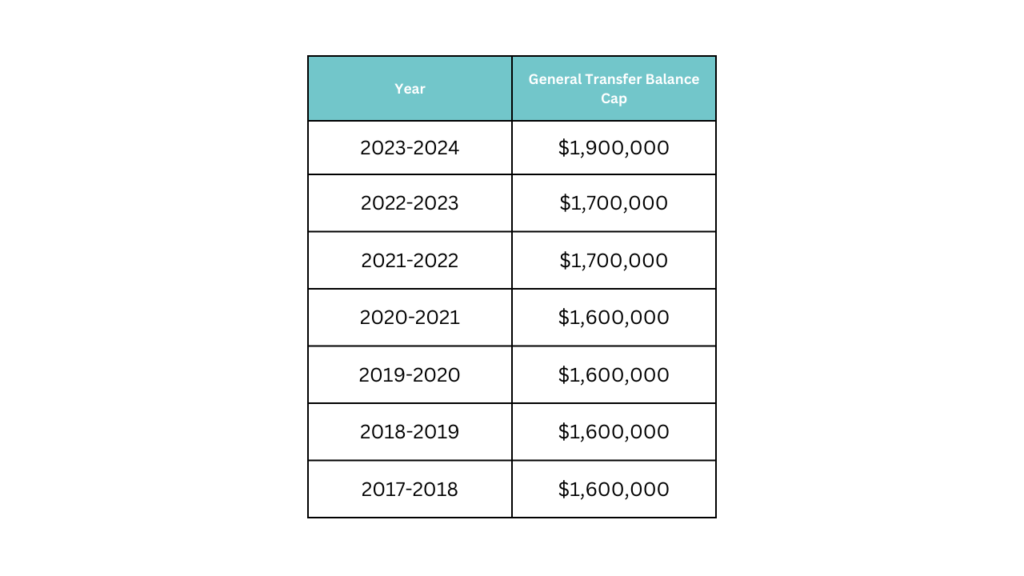It’s likely that no one in the halls of Congress ever anticipated the prospect that one day we’d see the maximum on transferrable assets lifted by $200,000. If this is the case, what does this imply, and how will this affect the way we handle our retirement accounts?
To begin, let’s delve further into the concept of transfer balance cap and its indexation. It is generally known that the transfer balance cap indexation is scheduled to grow by $200,000 on the first of July 2023 (total: $1.9 mill). This is a rather technical term, and it might be difficult to grasp for new trustees. As a result, we have opted to streamline the procedure so that you can gain a better understanding.

Table of Contents
What is a Transfer Balance Cap?
First things first, let’s try to get a better grasp on what exactly a Transfer Balance Cap is. It is something people refer to as a lifetime limit on the total amount of wealth that they are permitted to move into their retirement phase in order to support super income streams. It begins on the day that you become qualified to get an income stream during the retirement period and continues until the day that you pass away.
To put it another way, it is a limited record of all the transfers of monies that have been deposited into your superannuation account. In other words, it is a record of your superannuation history.
#1 General Transfer Balance Cap

#2 Defined Benefit Income Cap

How is indexation Calculated?
This is done in compliance with the provisions of the Income Tax Assessment Act of 1997, specifically section 294.40. Calculating indexation looks like this:
= unused cap * Indexation amount
Unused cap = Highest TBA/ (30/6/year) ÷ PTBC/(30/6/year)
TBA = Transfer Balance Amount
PTBC = personal transfer balance cap
Your new indexation amount would be $200,000, as the cap indexation is set to increase to that amount in July of the following year; as shown in the table above for the general transfer balance cap ($1.9 million – $1.7 million).
For example, let’s imagine that you haven’t used up 38% of your cap yet; this would be equivalent to 38% multiplied by $200,000, which would suggest that you have an unused space worth of $76,000 in your superannuation account.
What does the increased cap indexation mean to me?
The importance of this may be broken down into two distinct parts that go hand in hand with one another. If you have already spent all $1.6 million of your cap in the past, there will be no indexation for you because the maximum has been achieved at that point in time. If this has already happened, there will be no indexation for you. Even if you try switching pensions, it will not make a difference because the indexation system will record the maximum amount of money that you’ve deposited into your superannuation account.

On the other hand, those who haven’t can take solace in the knowledge that the development will result in an increase in the individually capped amounts that apply to them. However, this would be contingent on the amount that you already have. For instance, if you have one million dollars in your current account, you still have a gap of half a million dollars. After the first of July, you will have an unused space of 0.9 million due to the enhanced indexation that was discussed earlier.
If you haven’t started saving for retirement yet, you might be contemplating whether or not to wait until July 1st to do so in order to take benefit of the full value of indexation. This is something to think about if you haven’t started saving yet and that is perfectly okay, but you should bear in mind that obtaining a head start has a number of advantages, such as preventing you from having to pay taxes on income from investments (ECPI)
If you are interested in gaining additional insight on the ECPI, make your way over to this site.
What happens if I exceed my cap limit?
Earnings on any surplus amount in your retirement account will be subject to taxation at 15% on your marginal tax rate. You will be given up to 60 days to decide which solution you’d pick; either transfer 85% of your additional savings into an accumulation amount or withdraw it as a lump sum amount in order to assist you in satisfying your income tax liability. If you do not remove any of your excess concessional contributions, you run the danger of having your non-concessional payments subject to a tax rate of up to 94%.
Take into consideration that if you leave the excess concessional contributions in your super, you will be responsible for paying any additional tax that is owed as well as the ECC fee out of your own personal funds.
There is no need to panic since as soon as it is decided that you have exceeded your limit, a letter and a notice of assessment (NOA) will be issued to you. This will ensure that you are not penalised in any way for going over .
In need of assistance? Talk to us!

We are aware that there is a tremendous deal of information to comprehend, and we are here to offer SMSF audits support services anytime it is necessary. You are welcome to get in touch with us and discuss your concerns with one of the qualified super fund auditor we have here at Mint Super Audit.




